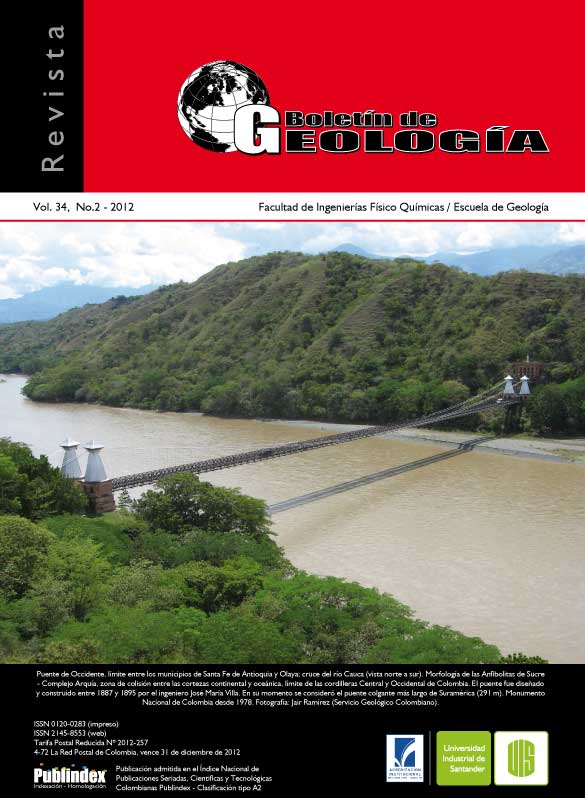STRATIGRAPHY AND DEPOSIT ENVIRONMENTS OF THE ARENISCA DE CHIQUINQUIRA AROUND ITS TYPE LOCALITY
Published 2013-04-01
How to Cite
Abstract
The Arenisca de Chiquinquira can be divided and mapped into five contrasted lithological segments, which have been denominated from base to top as A, B, C, D and E. Segments A, C and E are predominantly sandy, whereas segments B and D are lutaceous. Sandy facies are composed of 81% of quartzarenites and 19% of sublithoarenites. These rocks accumulated into a progradating shallow marine, tide-dominated environment (subtidal zone and intertidal flat), under a lower flow hydraulic regime. Lutaceous facies represent a calm marine offshore bottom, which was affected by quick accumulations of sandy or mixed sediments (sandy clastic material and shell remains). These quick accumulations of sediments occurred as a result of sediment gravitaty flows related to storms (storm beds). Occasionally, the storms deposited massive flows of sand or mixed sediments in channels or traverse depressions to the coast over the intertidal flat.
The measured thickness of the Arenisca de Chiquinquira is 780 m. Upper Albian is represented along the segments A and B, while segments C, D and E represent the Cenomanian. Differential tectonic subsidence related to NW-SE normal faulting took place during the early Cenomanian, which was concomitant with sedimentation of the lower part of the segment C.
Keywords: Arenisca de Chiquinquira, stratigraphy, facies, shallow marine environment, storm beds, Upper Albian-Cenomanian.
Downloads
References
Boyd, R., Dalrymple, R. and Zaitlin, B.A. 1992. Classification of clastic coastal depositional environments. Sedimentary Geology, 80 (3-4): 139-150
Brenner, R.L. and Davis, K.D. 1973. Storm-generated coquinoid sandstone: Genesis of high-energy marine sediments from the Upper Jurassic of Wyoming and Montana. Geological Society of America Bulletin, 84 (5): 1685-1698
Coleman, J.M. 1976. Deltas: Processes of deposition & models for exploration. Continuing Education Publication Company, Inc. United States of America, 102p.
Dalrymple, R.W. 1992. Tidal Depositional systems. En: Facies Models. Walker, R. G. and James, N. P. (Ed.), Geological Association of Canada, pp. 195-218.
Etayo, F., Cediel, F. y Cáceres C. 1997. Mapa de distribución de facies y ámbito |tectónico a través del Fanerozoico de Colombia. Escala 1:1’500.000. KL Albiano Medio-Superior & KU Cenomaniano. GEOTEC LTDA. Editor INGEOMINAS.
Etayo, F. 1968b. El sistema Cretáceo en la región de Villa de Leiva y zonas próximas. Universidad Nacional de Colombia, Geología Colombiana, (5): 3-74. Bogotá
Fabre, A. 1985. Dinámica de la sedimentación Cretácica en la región de la Sierra Nevada del Cocuy (Cordillera Oriental de Colombia). En: Proyecto Cretácico, Publicación Geológica Especial INGEOMINAS No. 16. Bogotá, pp. XIX-1 a XIX-20.
Folk, R.L. 1974. Petrology of sedimentary rocks. Hemphill Publishing Co. Austin, 182p.
